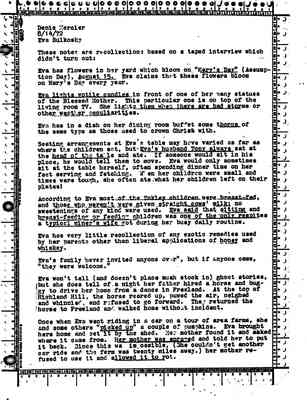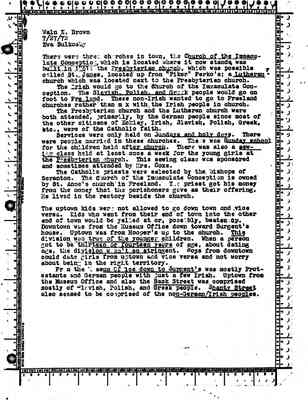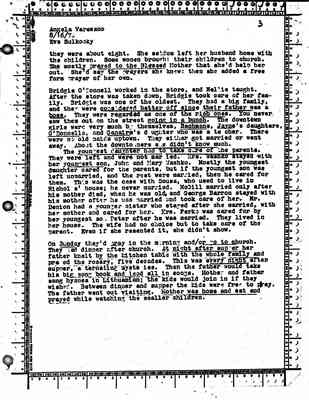Pages
25
Denis Mercier 8/14/72 Eva Sulkosky
These notes are recollections based on a taped interview which didn't turn out:
Eva has flowers in her yard which bloom on “Mary’s Day” (Assumption Day), August 15. Eva claims that these flowers bloom on Mary’s Day every year.
Eva lights volatile candles in front of one of her many statues of the Blessed Mother. This particular one is on top of the living room TV. She lights them when there are bad storms or other weather peculiarities.
Eva has in a dish on her dining room buffet some thorns of the same type as those used to crown christ with.
Seating arrangements at Evas table may have varied as far as where the children sat, but-Eva’s husband Tony always sat at the head of the table and ate. If someone would sit in his place he would tell them to move. Eva would only sometimes sit at the table herself, often spending dinner time on her feet serving and fetching. When her children were small and times were tough she often ate what her children left on their plates!
According to Eva most of the Eckley children were breast-fed , and those who weren't were given straight cows’ milk: no sweetenings of any kind were used. Eva said that sitting and breast-feeding or feeding children was one of the only respites a typical miner’s wife got during her busy daily routine.
Eva has very little recollection of any exotic remedies used by her parents other than liberal applications of honey and whiskey.
Eva’s family “never invited anybody over”, but if anyone came “they were welcome.”
Eva wont tell (and doesn’t place much stock in) ghost stories, but she does tell of a night her father hired a horse and buggy to drive her home from a dance in Freeland. At the top of Highland Hill, the horse reared up, pawed at the air, neighed and whinnied, and refused to go forward.They returned the horse to freeland and walked home without incident.
Once when Eva went riding in a car on a tour of area farms, she and some others “picked up” a couple of pumpkins. Eva brought hers home and set it by the shed. Her mother found it and asked where it came from. Her mother was enraged and told her to put it back. Since this was impossible, (she couldn’t get another car ride and the farm was twenty miles away.) Her mother refused to use it and allowed it to rot.
26
Waln K. Brown 7/27/72 Eva Sulkosky
There were three churches in town, the Church of the Immaculate Conception, which is located where it now stands, was built in 1861: the Presbyterian Church, which was possible called St. James, located up from “Piker” Ferko’s; a Lutheran Church which was located next to the Prebyterian Church. The Irish would go to the Church of the Immaculate Conception. The Slavish, Polish, and Greek people would go on foot to Freeland. These non-Irish wanted to go to Freeland churches rather than mix with the Irish people in church. The Presbyterian Church and the Lutheran Church were both attended, primarily, by the German people since most of the other citizens of Eckley, Irish, Slavish, Polish, Greek, etc., were of the Catholic faith Services were only held on Sundays and holy days. There were people married in these churches. There was Sunday school for the children held after church . There was also a sewing class held at least once a week for the young girls at the Presbyterian Church. This sewing class was sponsored and sometimes attended by Mrs. Coxe. The Catholic priests were selected by the bishops of Scranton. The Church of the Immaculate Conception was owned by St. Anne’s Church in Freeland The priest got his money from the money that the parishioners gave as their offering. He lived in the rectory besides the church.
The uptown kids were not allowed to go down town and vice versa. Kids who went from their end of town to the other end of town would be yelled at or, possibly, beaten up. Downtown was from the Museum Office down towards Surgent’s house. Uptown was from the Hooper’s up to the church. This division was true of the younger children. When a person got to be thirteen or fourteen years of age, about dating age, the division wasn't so stringent. Boys from downtown could date girls from uptown and vice versa and not worry about being in the right territory. From the Museum Office down to Surgent’s was mostly Protestants and German people with just a few Irish. Uptown from the Museums Office and also the Back Street was comprised mostly of Slavish, Polish, and Greek people. Shanty Street also seemed to be comprised of the non-German/Irish people.
27
Waln K. Brown 8/14/72 Eva Sulkosky
The parlor in Eva’s house when she was a child was very similar to the parlors of other Eckley people. The floors had no carpeting but were exposed wooden floors. The floors were scrubbed every week to keep them clean and fresh looking. The floors were hand scrubbed with soap and water. In about 1918, Eva’s mother had linoleum flooring put throughout the first floor of the house. The walls had only religious pictures on them, as well as other religious pictures throughout the house. Very few other pictures were hung on the walls and nothing but religious pictures in the parlor. This room was furnished in wood. A solid back rocking chair with no cushion was in here. Two or three solid wooden chairs were also present. Against one wall was a chest-of-drawers-like piece of furniture which resembled a bureau. In this piece of furniture were kept cloth goods, undergarments, towels, and tablecloths. On the top of this piece of furniture were some religious candles and other religious objects. These religious articles were placed on top of a hand-embroidered piece of fabric which was white in color. In the middle of the room there was a round table on which a white table cloth was lain. This table cloth reached to the floor. On top of the table stood a kerosene lamp. This was the only object on the table. It was also the only light in the room. The parlor was always kept clean, but was not the main living room in the house. The kitchen was the room which the family used most. The kitchen also had religious pictures and objects in it. After every supper meal the family would pray at Eva’s house. This seems to have been a standard procedure in Catholic Eckley homes. After the meal the father would lead the family in prayer procedures. The rosary beads were recited, prayers were recited, and the family would also sing a few religious songs. There was no other special religious area in the house. The dining table was the place where the religious proceedings occured for the family as a unit. Girls would get married in Eckley at an early age. A girl of fourteen was considered old enough to be married, and a girl of this age getting married was not uncommon. The average marrying age seems to have been about seventeen years old. Most of the newlyweds would live with either the man’s or woman's parents This was due to the lack of houses for every married couple in Eckley. It depended upon how many people were in the family as to where the new couple would sleep. Many times the new couple would sleep’n the parlor. Thus the parlor was not used at all as a parlor or living area, but rather it was used as the bedroom for the new couple.
28
Angela Varesano 8/18/72 Eva Sulkosky
Some mothers feel that they’re (the kids) better off dead because they’re angels. Her mother always said, “When they die when they’re young, they’re angels; when they die when they’re older, who knows what they’ll be.” Eva always used to pray that God would take care of her kids, that they’d do nothing wrong. She always prayed that if any one of the kids had to suffer or get sick, let it be her rather than her children. She said that some people, some mothers (like Mrs. Zosak) were taught; they could stand to look at suffering. She remembers when Mrs. Zosak’s baby was dying that Susie’s husband was crying, but Mrs. Zosak never shed a tear. She was taught like that. Eva said that she could never stand the thought of any child dying, especially one of her children. She always prayed that if any one of her kids were to die, let it be her instead. She said, “I never thought of ‘damned’ (in regards to the prayers of other mothers i mentioned); I just prayed that god would take care of them. In regards to the number of kids, she mentioned she didn't know of any means used at the time to prevent births. She said that the number of births of children depended sometimes on heredity, “It runs in the family.” Also since the women were always up and around and active, perhaps that had something to do with the number of children. She said that with all the work she had to do, and that women in general had to do, she didn't have much time to spend with her husband. Her house burned down and they went to live with her mother-in-law. They couldn't get another house for four years. Mrs. Coxe took care of the old people by contributing some money for their support. Whichever in-law they were living with, they took care of in their old age.If you lived by yourself, whichever in-law the husband, with the wife's advice, liked would live with them. Before, the daughter-in-law had to take advice from the mother-in-law. Sometimes she’d criticize. She had to take care of the children and only got to sit down when she nursed the kids to about one year. When the baby cried, they picked them up and nursed them. Women wore buttons up the front and undershirts underneath. They wore bras when they weren't nursing a baby. They usually wore a skirt and a waist blouse, “we used to drink more milk and tea to help the mother have more.” The women used to nurse the babies while sitting on the boardwalks across the ditch. They would put a diaper over the baby and let them nurse. Eva nursed in the house because she had lots of work to do. You even could do it in church by covering the breast with a diaper. She never went to church when she had to nurse and had small children. Eva started taking them to church when
29
Angela Varesano 8?18/72 Eva Sulkosky
they were about eight. She seldom left her husband home with the children. Some women brought their children to church. She mostly prayed to the Blessed Mother that she’d help her out. She’d say the prayers she knew: then she added a free form prayer of her own.
Bridgie O’Donnell worked in the store, and Nellie taught. After the store was taken down, Bridgie took care of her family. Bridgie was one of the oldest. They had a big family and they were considered better off since the father was a boss. They were regarded as one of the rich ones. You never saw them out on the street going as a bunch. The downtown girls were very much by themselves, Bachmans, Jayne’s daughters, O’Donnells, and Ganairmls daughter who was the teacher. There were no old maids uptown. They either got married or went away. About the downtowners she didn't know much. The youngest daughter had to take care of the parents. They were left and were not married. Mrs. Washko stayed with her youngest son, John and Mary Washko. Mostly the youngest daughter cared for the parents, but if the youngest son was left unmarried, and the rest were married, then he cared for them. This was the case with Sousa, who used to live in Nichole S’ house; he never married. McGill married only after his mother died, when he was old, And George Barren stayed with his mother after he was married and took care of her. Mr. Denison had a younger sister who stayed after she was married, with her mother and cared for her. Mrs. Ferko was cared for by her youngest son Peter after he was married. They lived in her house. The wife had no choice but to take care of the parent. Even if she resented it, she didn't show.
On Sunday they’d pray in the morning and/or go to church. They had dinner after church. At night after supper her father knelt by the kitchen table with the whole family and prayed the rosary, five decades. This was every night after supper, alternating mysteries. Then the father would take his big song book and lead all in songs. Mother and father sang hymns in Lithuanian; the kids would join in if they wished. Between dinner and supper the kids were free to play. The father went out visiting. Mother was home and sat and prayed while watching the smaller children.




